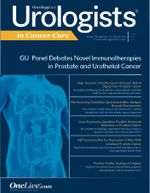High Genomic Classifier Score Increases Risk of Dying From Prostate Cancer
Results from a study using the Decipher Prostate Cancer Classifier noted that its use added very strong data about the likelihood of patients with prostate cancer dying within 10 years.
Bruce J. Trock, PhD
A clinical dilemma that urologists face after prostate cancer patients undergo radical prostatectomy (RP), and whose pathology indicates aggressive characteristics such as high-stage or high Gleason score, is how further treatment should progress. The time course to prostate cancer specific mortality (PCSM) is highly variable for men with high risk after RP, and a substantial proportion of men will die of other causes. Accurately stratifying risk of PCSM may allow more appropriate therapy decisions.
Although these men are at a higher risk of death, most of them will be cured by surgery. Clinicians in general would prefer to avoid additional treatment after RP. Results from a study using the Decipher Prostate Cancer Classifier noted that its use added very strong data about the likelihood of dying within 10 years.
The findings could inform the treatment algorithm in men who are high to very high risk after RP by stratifying risk associated with PCSM. The genomic classifier showed a three-fold increase in risk of death even for adjusting for very high risk men, said lead author Bruce J. Trock, PhD, Director, Division of Epidemiology, Professor of Urology, Epidemiology, Oncology, and Environmental Health Services of the Brady Urological Institute, Johns Hopkins University, who presented the results during the 2016 American Urologic Association Annual Meeting.
“Urologists who treat men with adverse pathology or men with positive margins are trying to decide if they are candidates for adjuvant therapy. The other option is waiting until recurrence and giving these patients salvage therapy,” said Trock. The genomic classifier could also be considered for use in men at the time of biochemical recurrence. The Decipher Prostate Cancer Classifier evaluates 22 genomic markers across multiple biological pathways implicated in prostate cancer, to predict the probability of metastasis postprostatectomy.
“The patients who are at very high risk are probably the patients who will have the greatest utility and derive the most benefit,” said Trock. “Men with lower risk are probably going to be cured with surgery. The genomic classifier will identify the patients who have a rapid, aggressive progression.”
Trock and colleagues investigated 511 men with adverse pathologic features (pT3N0/N1, positive margins, or RP Gleason score ≥7) who underwent RP from 1988 — 2010 at three institutions (Mayo, Johns Hopkins, Cleveland Clinic). The primary endpoint was PCSM within 10 years of RP (PCSM10). Men with less than 10 years follow-up were excluded and men who died of prostate cancer after 10 years were censored. Median follow-up was 13.0 years in censored patients and 6.0 years in men with PCSM10. Among all men, a high GC score increased PCSM10 risk nearly 4-fold, HR=3.87 (P < .0001). Among men with BCR2 or MET after RP, high GC increased PCSM10 risk over 2 — 3 fold (P = .0007 and 0.005, respectively), and area under the curve of 0.743 and 0.671. For both BCR2 and MET the GC was the only significant predictor besides RP Gleason 8 — 10.
When researchers adjusted for clinical variables such as prostate-specific antigen and stage and grade, or using the validated Cancer of the Prostate Risk Assessment Postsurgical (CAPRA-S) nomogram, a high GC score still resulted in a 3- to 4-fold higher risk of dying than men with a lower score. A patient’s CAPRA-S scores are based on clinical risk factors such as presurgical PSA score, Gleason score, area around the prostate affected by cancer, and lymph node involvement.
“If we looked at categories within CAPRA-S, that is, men who were rated as low risk for death with CAPRA-S and men with a high score in GC had a 25% chance of dying within 10 years even though their CAPRA-S score was low risk. For men with high risk of CAPRA-S, if their GC was low, they only had an 18% chance of dying, whereas if they had a high GC score, their risk of dying was 56%.” Men at high risk by CAPRA-S and the GC “are candidates for clinical trials that are investigating treatments, such as enzalutamide, abiraterone, or docetaxel, that are moving into earlier settings in the metastatic setting,” added Trock.
Trock believes the patients at very high risk will benefit the most from these findings. “Men with lower risk are probably going to be cured with surgery, but this will help identify patients who would have a rapid, aggressive progression. In men with a rapid biochemical recurrence but a low value of GC, they had a low risk of dying from prostate cancer within 10 years.”
Karnes RJ, Ross A, Schaeffer E, et al. Validation of a genomic risk classifier to predict prostate cancer death in high risk patients. Presented at: 2016 American Urological Association Annual Meeting; May 6-10, 2016; San Diego, CA. Abstract MP07-01.




